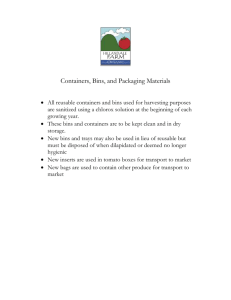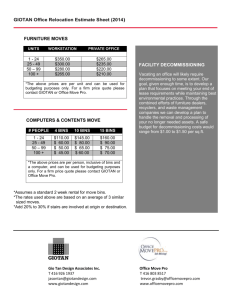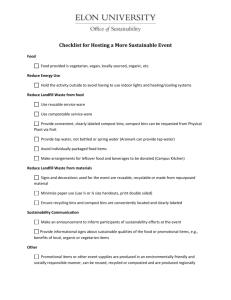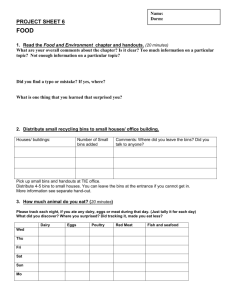Dress Rehearsal - The ACM-ICPC International Collegiate
advertisement
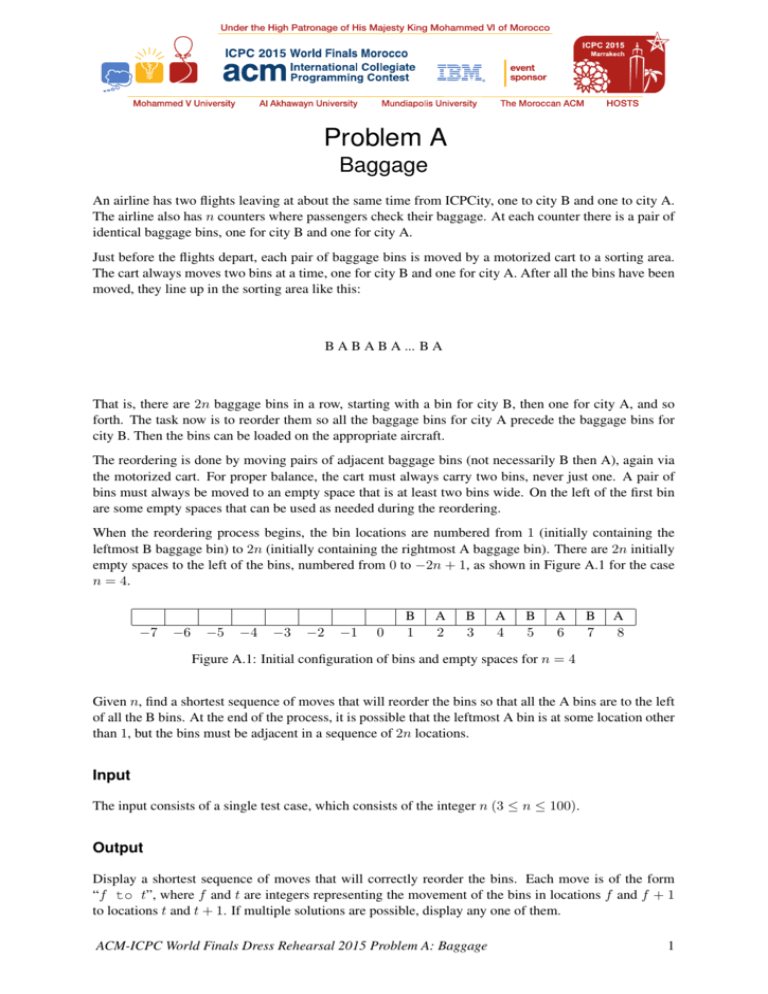
Problem A
Baggage
An airline has two flights leaving at about the same time from ICPCity, one to city B and one to city A.
The airline also has n counters where passengers check their baggage. At each counter there is a pair of
identical baggage bins, one for city B and one for city A.
Just before the flights depart, each pair of baggage bins is moved by a motorized cart to a sorting area.
The cart always moves two bins at a time, one for city B and one for city A. After all the bins have been
moved, they line up in the sorting area like this:
B A B A B A ... B A
That is, there are 2n baggage bins in a row, starting with a bin for city B, then one for city A, and so
forth. The task now is to reorder them so all the baggage bins for city A precede the baggage bins for
city B. Then the bins can be loaded on the appropriate aircraft.
The reordering is done by moving pairs of adjacent baggage bins (not necessarily B then A), again via
the motorized cart. For proper balance, the cart must always carry two bins, never just one. A pair of
bins must always be moved to an empty space that is at least two bins wide. On the left of the first bin
are some empty spaces that can be used as needed during the reordering.
When the reordering process begins, the bin locations are numbered from 1 (initially containing the
leftmost B baggage bin) to 2n (initially containing the rightmost A baggage bin). There are 2n initially
empty spaces to the left of the bins, numbered from 0 to −2n + 1, as shown in Figure A.1 for the case
n = 4.
−7
−6
−5
−4
−3
−2
−1
0
B
1
A
2
B
3
A
4
B
5
A
6
B
7
A
8
Figure A.1: Initial configuration of bins and empty spaces for n = 4
Given n, find a shortest sequence of moves that will reorder the bins so that all the A bins are to the left
of all the B bins. At the end of the process, it is possible that the leftmost A bin is at some location other
than 1, but the bins must be adjacent in a sequence of 2n locations.
Input
The input consists of a single test case, which consists of the integer n (3 ≤ n ≤ 100).
Output
Display a shortest sequence of moves that will correctly reorder the bins. Each move is of the form
“f to t”, where f and t are integers representing the movement of the bins in locations f and f + 1
to locations t and t + 1. If multiple solutions are possible, display any one of them.
ACM-ICPC World Finals Dress Rehearsal 2015 Problem A: Baggage
1
Sample Input 1
Sample Output 1
5
8
3
6
0
9
Sample Input 2
Sample Output 2
8
10 to -1
3 to 10
14 to 3
7 to 14
0 to 7
11 to 0
4 to 11
15 to 4
to
to
to
to
to
-1
8
3
6
0
ACM-ICPC World Finals Dress Rehearsal 2015 Problem A: Baggage
2
Problem B
Surely You Congest
You are in charge of designing an advanced centralized traffic management system for smart cars. The
goal is to use global information to instruct morning commuters, who must drive downtown from the
suburbs, how best to get to the city center while avoiding traffic jams.
Unfortunately, since commuters know the city and are selfish, you cannot simply tell them to travel
routes that take longer than normal (otherwise they will just ignore your directions). You can only
convince them to change to different routes that are equally fast.
The city’s network of roads consists of intersections that are connected by bidirectional roads of various
travel times. Each commuter starts at some intersection, which may vary from commuter to commuter.
All commuters end their journeys at the same place, which is downtown at intersection 1. If two commuters attempt to start travelling along the same road in the same direction at the same time, there will be
congestion; you must avoid this. However, it is fine if two commuters pass through the same intersection
simultaneously or if they take the same road starting at different times.
Determine the maximum number of commuters who can drive downtown without congestion, subject
to all commuters starting their journeys at exactly the same time and without any of them taking a
suboptimal route.
Figure B.1: Illustration of Sample Input 2.
In Figure B.1, cars are shown in their original locations. One car is already downtown. Of the cars at intersection 4, one can go along the dotted route through intersection 3, and another along the dashed route
through intersection 2. But the remaining two cars cannot reach downtown while avoiding congestion.
So a maximum of 3 cars can reach downtown with no congestion.
Input
The input consists of a single test case. The first line contains three integers n, m, and c, where n
(1 ≤ n ≤ 25 000) is the number of intersections, m (0 ≤ m ≤ 50 000) is the number of roads, and c
(0 ≤ c ≤ 1 000) is the number of commuters. Each of the next m lines contains three integers xi , yi , and
ti describing one road, where xi and yi (1 ≤ xi , yi ≤ n) are the distinct intersections the road connects,
and ti (1 ≤ ti ≤ 10 000) is the time it takes to travel along that road in either direction. You may assume
ACM-ICPC World Finals Dress Rehearsal 2015 Problem B: Surely You Congest
3
that downtown is reachable from every intersection. The last line contains c integers listing the starting
intersections of the commuters.
Output
Display the maximum number of commuters who can reach downtown without congestion.
Sample Input 1
Sample Output 1
3
1
2
2
2
2
3
2
3
3
3
2
42
1
1
Sample Input 2
Sample Output 2
4
1
1
4
4
4
3
4
2
3
2
3
4
5
5
4
5
6
4 4 1
ACM-ICPC World Finals Dress Rehearsal 2015 Problem B: Surely You Congest
4
Problem C
Factors
The fundamental theorem of arithmetic states that every integer greater than 1 can be uniquely represented as a product of one or more primes. While unique, several arrangements of the prime factors may
be possible. For example:
10 = 2 · 5
20 = 2 · 2 · 5
=5·2
=2·5·2
=5·2·2
Let f (k) be the number of different arrangements of the prime factors of k. So f (10) = 2 and f (20) = 3.
Given a positive number n, there always exists at least one number k such that f (k) = n. We want to
know the smallest such k.
Input
The input consists of at most 1 000 test cases, each on a separate line. Each test case is a positive integer
n < 263 .
Output
For each test case, display its number n and the smallest number k > 1 such that f (k) = n. The
numbers in the input are chosen such that k < 263 .
Sample Input 1
Sample Output 1
1
2
3
105
1 2
2 6
3 12
105 720
ACM-ICPC World Finals Dress Rehearsal 2015 Problem C: Factors
5
This page is intentionally left blank.
Problem D
Maze Reduction
Jay runs a small carnival that has various rides and attractions. Unfortunately, times are tough. A recent
roller coaster accident, flooding in the restrooms, and an unfortunate clown incident have given Jay’s
carnival a bad reputation with the public. With fewer paying customers and reduced revenue, he will
need to cut some costs to stay in business.
One of the biggest carnival attractions is a large, confusing maze. It consists of a variety of circular
rooms connected by narrow, twisting corridors. Visitors love getting lost in it and trying to map it out. It
has come to Jay’s attention that some of the rooms might be effectively identical to each other. If that’s
the case, he will be able to reduce its size without anyone noticing.
Two rooms A and B are effectively identical if, when you are dropped into either room A or B (and you
know the map of the maze), you cannot tell whether you began in A or B just by exploring the maze.
The corridor exits are evenly spaced around each room, and you cannot mark or leave anything in a
room (in particular, you cannot tell whether you have previously visited it). The only identifying feature
that rooms have is their number of exits. Corridors are also twisty enough to be indistinguishable from
each other, but when you enter a room you know which corridor you came from, so you can navigate a
little by using the order they appear around the room.
Jay has appealed to the Association for Carnival Mazery for help. That’s you! Write a program to
determine all the sets of effectively identical rooms in the maze.
Input
The input consists of a single test case. The first line contains an integer n, the number of rooms in the
maze (1 ≤ n ≤ 100). Rooms are numbered from 1 to n. Following this are n lines, describing each room
in order. Each line consists of an integer k, indicating that this room has k corridors (0 ≤ k < 100), and
then k distinct integers listing the rooms each corridor connects to (in clockwise order, from an arbitrary
starting point). Rooms do not connect to themselves.
Output
Display one line for each maximal set of effectively identical rooms (ignoring sets of size 1) containing
the room numbers in the set in increasing order. Order the sets by their smallest room numbers. If there
are no such sets, display none instead.
ACM-ICPC World Finals Dress Rehearsal 2015 Problem D: Maze Reduction
7
Sample Input 1
Sample Output 1
13
2 2 4
3 1 3 5
2 2 4
3 1 3 6
2 2 6
2 4 5
2 8 9
2 7 9
2 7 8
2 11 13
2 10 12
2 11 13
2 10 12
2 4
5 6
7 8 9 10 11 12 13
Sample Input 2
Sample Output 2
6
3
0
1
1
2
1
none
3 4 5
1
1
1 6
5
ACM-ICPC World Finals Dress Rehearsal 2015 Problem D: Maze Reduction
8
Problem E
Surveillance
The International Corporation for Protection and Control (ICPC) develops efficient technology for, well,
protection and control. Naturally, they are keen to have their own headquarters protected and controlled.
Viewed from above, the headquarters building has the shape of a convex polygon. There are several
suitable places around it where cameras can be installed to monitor the building. Each camera covers a
certain range of the polygon sides (building walls), depending on its position. ICPC wants to minimize
the number of cameras needed to cover the whole building.
Input
The input consists of a single test case. Its first line contains two integers n and k (3 ≤ n ≤ 106 and
1 ≤ k ≤ 106 ), where n is the number of walls and k is the number of possible places for installing
cameras. Each of the remaining k lines contains two integers ai and bi (1 ≤ ai , bi ≤ n). These integers
specify which walls a camera at the ith place would cover. If ai ≤ bi then the camera covers each wall j
such that ai ≤ j ≤ bi . If ai > bi then the camera covers each wall j such that ai ≤ j ≤ n or 1 ≤ j ≤ bi .
Output
Display the minimal number of cameras that suffice to cover each wall of the building. The ranges
covered by two cameras may overlap. If the building cannot be covered, display impossible instead.
Sample Input 1
Sample Output 1
100 7
1 50
50 70
70 90
90 40
20 60
60 80
80 20
3
Sample Input 2
Sample Output 2
8 2
8 3
5 7
impossible
Sample Input 3
Sample Output 3
8 2
8 4
5 7
2
ACM-ICPC World Finals Dress Rehearsal 2015 Problem E: Surveillance
9
This page is intentionally left blank.
Problem F
Support Vector Machine
In machine learning, the Support Vector Machine (SVM) is a popular classifier. Given an n-dimensional
vector x ∈ Rn , an SVM produces a label h(x) ∈ {−1, +1} depending on where x lies relative to an
n-dimensional hyperplane.
An example application is email spam classification. We could convert the text of an email into a vector
x of counts of word occurrences in the email. Each vector element would represent the count for one
dictionary word. Then a trained SVM could classify the email as ‘spam’ (h(x) = +1) or ‘non-spam’
(h(x) = −1).
Recall that for vectors x, y ∈ Rn ,
• xi represents the ith element of x,
• xT y =
• ||x|| =
Pn
i=1 xi yi
√
is the vector inner product of x and y, and
xT x is the length of vector x.
The parameters that define the SVM are w ∈ Rn and b ∈ R. The distance from a point x to the
hyperplane defined by (w, b) is
d(x) = (wT x + b)/||w||
so that the hyperplane is the set H = { x | d(x) = 0 } and is b/||w|| units from the origin at its closest.
Note also that w is orthogonal to the hyperplane. The SVM classifier is formally defined as
(
h(x) =
+ 1, if d(x) ≥ 0
− 1, otherwise
For this problem you are given SVM parameters and a list of query points. For each query x, identify
d(x).
Figure F.1: Rendering of the hyperplane (thick dashed line) and query points (circles) for the sample
input. Other dashed lines connected each query point to its closest point on the hyperplane.
ACM-ICPC World Finals Dress Rehearsal 2015 Problem F: Support Vector Machine
11
Input
The input contains one test case. The first line contains an integer 1 ≤ n ≤ 1000. The second line
contains n + 1 floating-point values which are the values of w1 , w2 , . . . , wn and b. Each remaining line
(up to the end of file) is a query vector x, given as n floating point values (in the same order as the
elements of w). There are at most 1000 queries. All floating point values in the input are in the range
[−1000, 1000] with at most 5 digits past the decimal point. At least one element of w will be non-zero.
Output
For each query x, print the value of d(x). The answer should be accurate to within 10−4 relative or
absolute error.
Sample Input 1
Sample Output 1
2
-1 2 3
-3 1
8.71 -2.35
3.57771
-4.65549
ACM-ICPC World Finals Dress Rehearsal 2015 Problem F: Support Vector Machine
12
